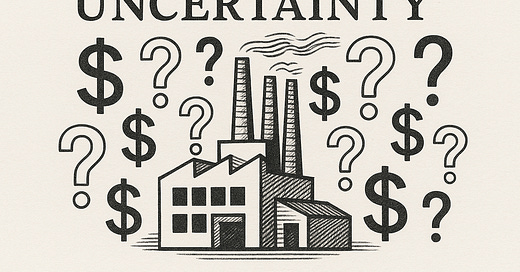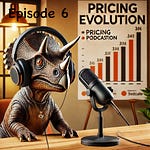I’d been looking at a few different fun topics for this episode, but in the end, there’s one topic which is dominating price discussions at the moment, and I couldn’t ignore it. So, this week’s podcast is about tariffs.
In the first half of the episode, I look at the more general questions: How to tariffs work? How were these particular tariff rates calculated? Will these tariffs cause companies to bring manufacturing jobs back to the US?
In the process, I talk about the key role of uncertainty: Companies are hesitant to make major changes and investments in response to conditions which seem temporary. And these tariffs seem like they may be very termporary. The Canada and Mexico tariffs have been announced and delayed and modified several times, and this newest “Liberation Day” round of tariffs announced on April 4th already appear to be the subject of further negotiations. This generally makes companies less likely to make major investments (such as moving factories) as a result.
Then, in the second half, I talk about the specific things that companies should consider doing from a pricing perspective as they deal with tariffs:
Don’t panic, and don’t predict. It’s a rapidly changing situation so give yourself the time to see what is happening and respond to the things that have actually happened to you cost thus far. Don’t try to guess what may be happening next in a fluid situation.
Base your prices on what your current cost to replace inventory is: the price to buy or build new product. Your current inventory was built up at older prices, but you’ll want to base your prices on what it will cost you to refill your inventory, not those old costs.
Focus on communicating clearly to your customers. Good pricing requires good communication. This means that if you are changing prices due to tariff-driven costs, you need to communicate that clealry to your customers. And if you’ve decided it’s important for you to absorb some or all of those costs, communicate that decision to absorb the costs to your customers as well. If you stay silent, they won’t see the value your sacrifice is giving them.
And as the tariffs disrupt your industry (which, after all, is what they are designed to do) be ready to talk to your own customers about lower cost substitute products you can help them trade down to if they are no longer willing to buy the same produce you’ve been selling them. And also, be ready to address possible opportunities as a result of previously lower-priced competitors suffering a bigger tariff impact than you have.
All together, this is the longest Pricing Evolution episode we’ve had yet, but it’s tackling an important issue and I hope you find it interesting and useful.
If you do, please share it with others who may also find it interesting. A recommendation from a friend is the best way for a podcast to find new listeners!














Share this post